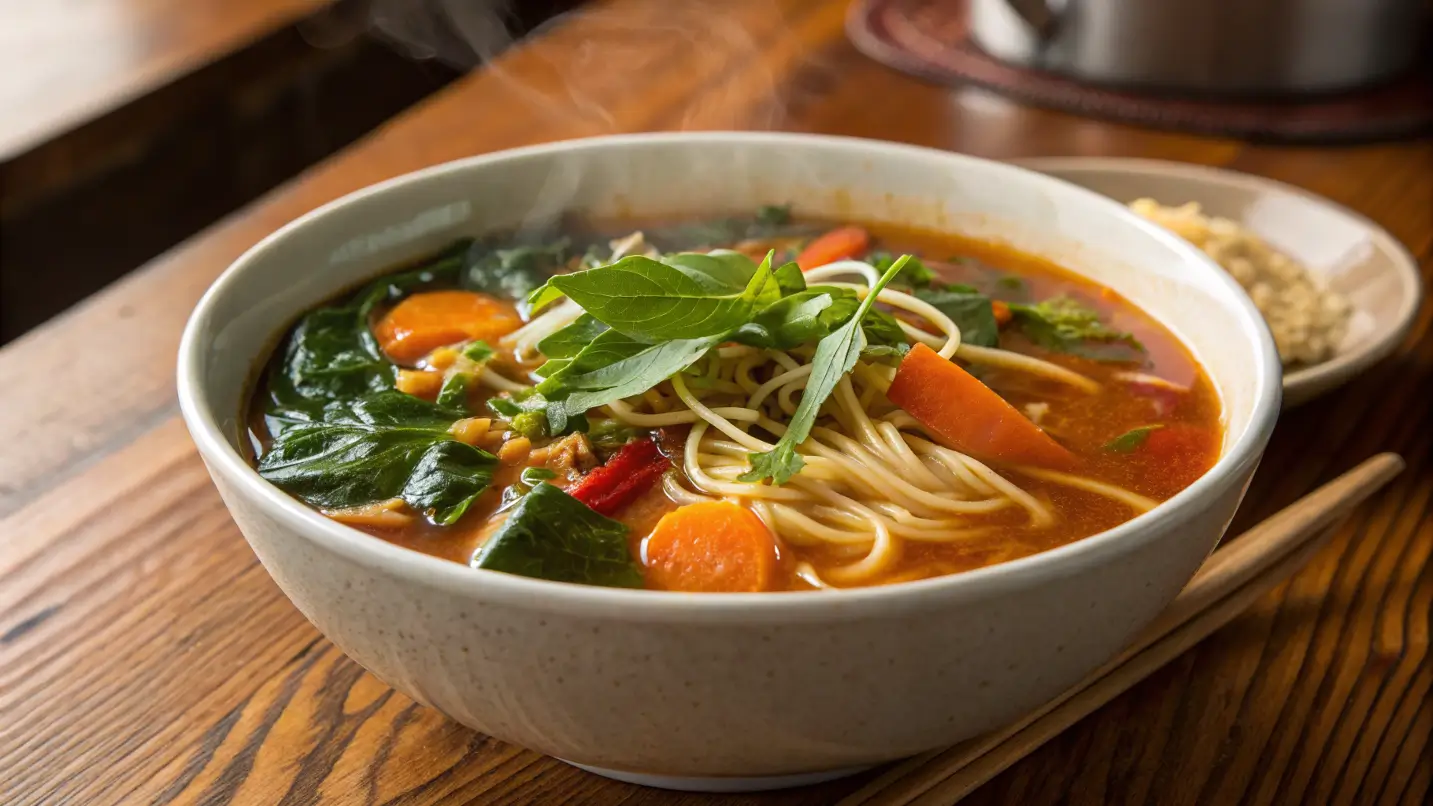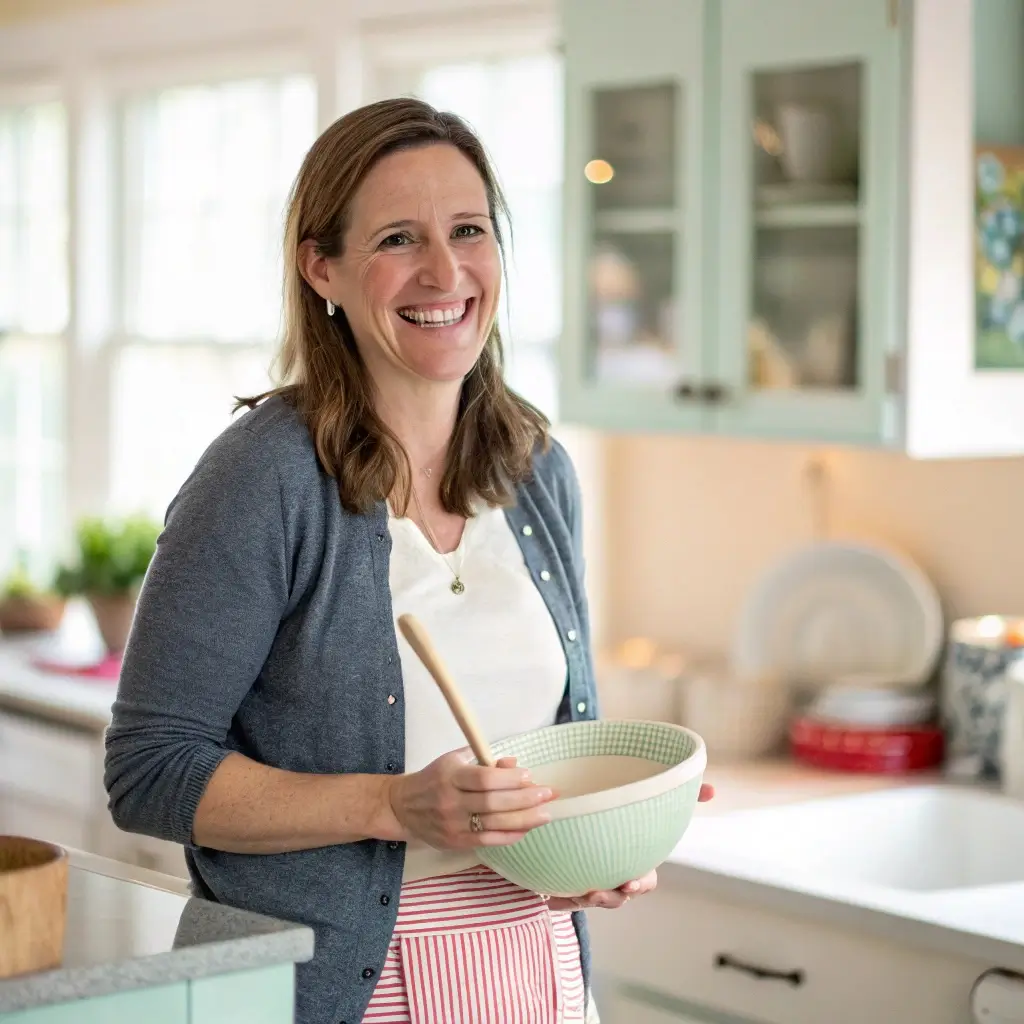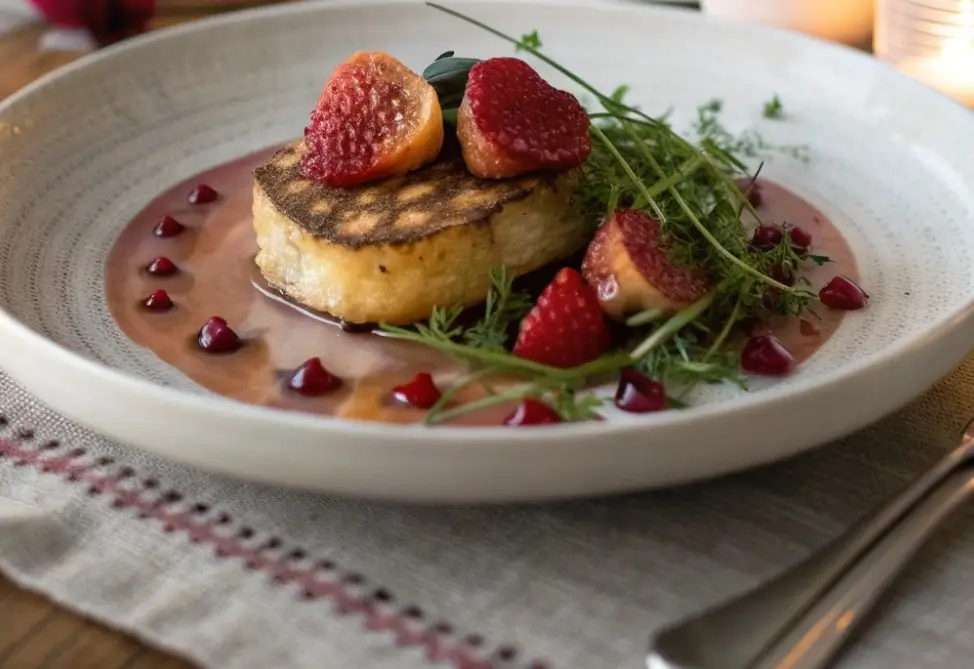Table of Contents
There’s something universally comforting about a warm bowl of noodle soup. Whether it’s sipped slowly on a rainy afternoon or slurped joyfully at a family gathering, special noodle soup transcends borders and blends culture, flavor, and emotion in a single dish.
In this ultimate guide, we’re diving deep into the world of special noodle soups. We’ll explore their global charm, dig into historical roots, break down ingredient essentials, and walk through recipes from various regions. Plus, we’ll touch on health benefits, answer burning questions, and provide practical cooking tips to help you master your own bowl of joy.
So, whether you’re a curious foodie, an aspiring home cook, or just craving something soul-warming, this guide has everything you need. Let’s get into Part 1!
Introduction to Special Noodle Soup
What Is Special Noodle Soup?
At its core, special noodle soup is a harmonious blend of noodles, flavorful broth, and a thoughtful assortment of toppings. But what makes it “special” isn’t just one magical ingredient—it’s the intention, variety, and balance that turn an ordinary soup into a comforting masterpiece.
Unlike basic versions, special noodle soups often combine slow-simmered broths with fresh herbs, spices, proteins, and region-specific noodles. The outcome? Layers of flavor that tell a story in every bite. From subtle and aromatic to bold and spicy, no two bowls are ever quite the same.
Across cultures, this dish is more than food—it’s a tradition, a celebration, and sometimes even a remedy. You’ll find it served during holidays, passed down in family recipes, or whipped up as a quick fix for a cold. No wonder it’s adored around the globe!
And while the components may differ from one country to the next, the heart of this dish stays the same: it’s all about warmth, nourishment, and flavor-packed comfort.
The Global Appeal of Noodle Soups
From the bustling streets of Southeast Asia to cozy family kitchens in East Asia and beyond, noodle soups are everywhere. But let’s break down what makes each one unique—and why they’ve taken over the world’s taste buds.
-
Vietnamese Pho: Known for its light yet aromatic broth and rice noodles, Pho is often seasoned with star anise, cinnamon, and cloves, then topped with fresh herbs and citrus. It’s balanced, fragrant, and utterly soothing.
-
Japanese Ramen: Rich, umami-filled, and soul-satisfying. Ramen features wheat noodles, a range of broths (like miso, shoyu, or creamy tonkotsu), and toppings like soft-boiled eggs, seaweed, and scallions. It’s all about boldness and variety.
-
Korean Janchi-guksu: Often enjoyed during celebrations like weddings and birthdays, this Korean noodle soup is both simple and elegant. Its light broth, typically made with ingredients like dried anchovies and kelp, creates a clean, savory base. Served with thin wheat noodles and finely sliced vegetables, it’s a dish that symbolizes joy and longevity.
-
Tibetan Thukpa: A hearty noodle soup from the Himalayas, Thukpa is designed to warm the body in chilly mountain regions. It features robust wheat noodles in a spiced broth, often enriched with regional herbs and vegetables, reflecting the heart of Tibetan comfort food.
-
Taiwanese Beef Noodle Soup: Savory, slightly spicy, and deeply beefy—this dish is a national favorite in Taiwan. The broth is usually dark and soy-based, simmered with aromatics, and served with tender chunks of beef and chewy noodles.
Each variation carries a piece of its culture, making special noodle soups a beautiful tapestry of global tastes. No matter where you’re from, there’s a noodle soup with your name on it.
History and Cultural Significance
Origins and Evolution
The story of noodle soup is as rich and diverse as its flavors. Its roots trace back thousands of years, believed to have originated in East Asia, where noodles and broth were staples in early culinary traditions. Ancient records from China as far back as 4,000 years ago mention early forms of noodles made from millet or wheat, often consumed in warm broths.
As trade routes like the Silk Road developed, so did culinary exchange. Ingredients, techniques, and flavors began to travel across regions. Noodles journeyed from Asia to the Middle East and eventually to Europe, evolving based on local ingredients and tastes. These migrations birthed countless noodle variations—each shaped by regional resources and cultural identities.
In Japan, ramen was adapted from Chinese noodle dishes, eventually becoming a national obsession with its own subcultures and ramen shops on nearly every street. Meanwhile, Vietnam’s Pho emerged through a blend of French and Chinese culinary influence during colonial times, using beef and rice noodles in a clear, aromatic broth.
Korea’s noodle soups such as Janchi-guksu are deeply tied to family and communal rituals. In contrast, Tibetan Thukpa grew as a necessity—something hearty and warming in high-altitude climates. In every region, noodle soup became more than sustenance—it was nourishment for the soul, shaped by environment, history, and necessity.
This evolution reflects the way noodle soup bridges geography, economics, and identity—always adaptable, always essential.
Symbolism and Traditions
In many cultures, noodles carry deep symbolic meaning beyond their role as food. Especially in East Asia, long noodles are viewed as emblems of a long and prosperous life. They’re often served during important occasions like birthdays and the Lunar New Year, where their unbroken length represents continuity, good fortune, and enduring happiness.
For instance, in Chinese culture, longevity noodles (changshou mian) are served during birthdays and festive occasions, where breaking the noodle before eating is often considered bad luck. Similarly, in Korean culture, Janchi-guksu—literally meaning “banquet noodles”—is served during weddings and milestone birthdays to represent happiness and long life.
In Japan, slurping noodles is not only acceptable but encouraged. It shows appreciation for the meal and connects people through a shared, joyful act. These traditions foster community, gratitude, and mindfulness.
Noodle soups also appear in rituals for healing and comfort. They’re the go-to meal when someone’s feeling unwell—light, nourishing, and gentle on the stomach. Whether it’s chicken noodle soup in the West or rice noodle broth in Asia, there’s a universal belief in their restorative powers.
In every bowl, there’s heritage, hope, and a little bit of magic. That’s what makes special noodle soup not just a dish—but a celebration.
Ingredients and Preparation
Essential Ingredients
Creating a truly special noodle soup starts with choosing the right components. Let’s break down the essentials:
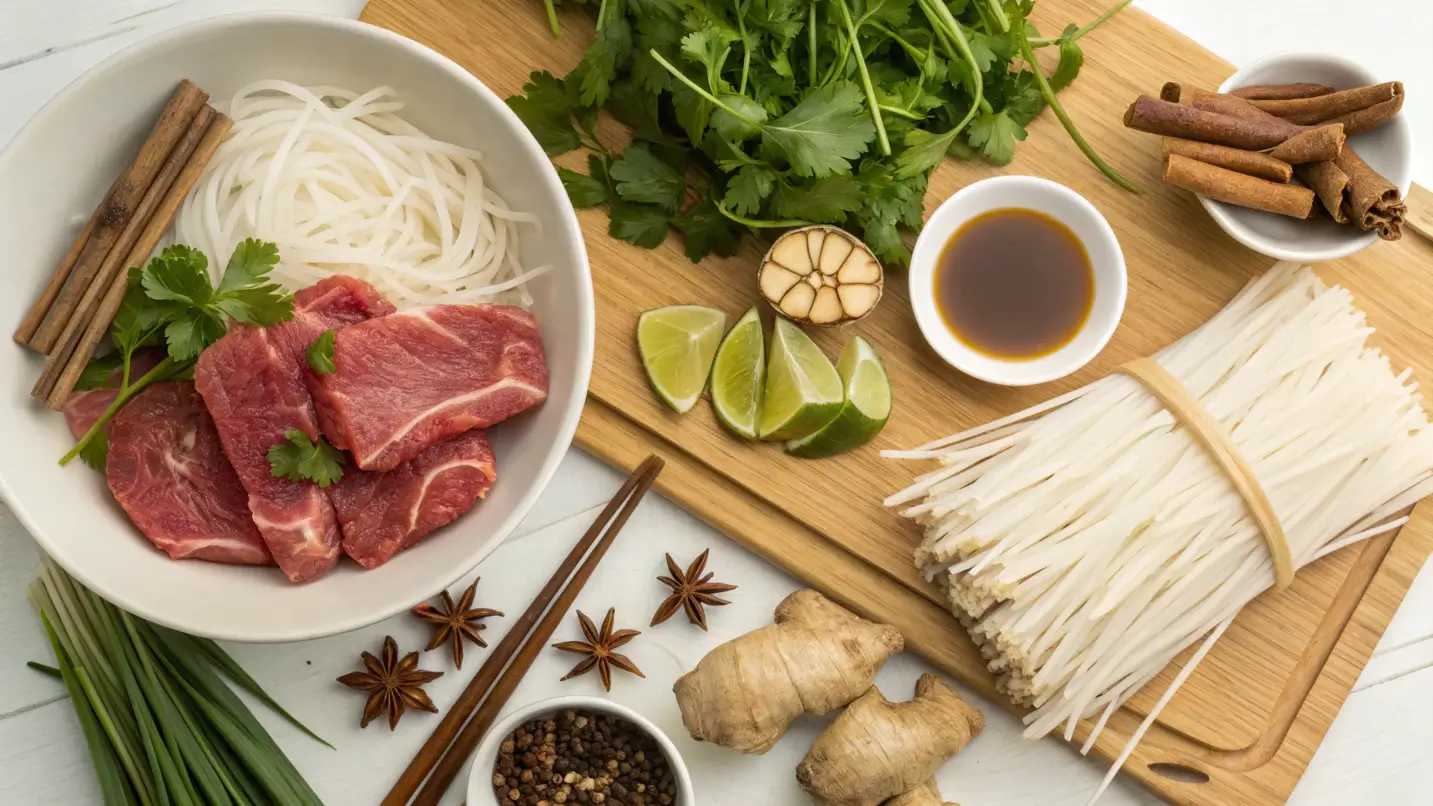
Broth Bases
The heart of any noodle soup lies in its broth. It can be rich and cloudy or light and clear. Common base options include:
-
Meat: Chicken or beef broths offer richness and depth.
-
Poultry: Chicken bones add umami and comfort.
-
Seafood: Shrimp shells or dried anchovies give an oceanic punch.
-
Vegetarian: Made with mushrooms, seaweed, onions, and carrots for earthy, clean flavors.
Noodles
Choosing the right noodle is just as crucial:
-
Rice noodles: Common in Southeast Asian dishes like Pho.
-
Wheat noodles: Used in ramen and udon.
-
Buckwheat noodles: Known as soba, offering a nutty taste.
-
Specialty noodles: Egg noodles, glass noodles, or handmade variants for unique textures.
Vegetables and Herbs
These add color, crunch, and balance:
-
Bean sprouts, bok choy, carrots, mushrooms, spinach, and corn.
-
Fresh herbs like cilantro, basil, green onions, and mint elevate aroma and freshness.
Seasonings and Condiments
A flavorful soup is layered with seasonings such as:
-
Soy sauce, tamari (gluten-free alternative), miso paste, sesame oil.
-
Fish sauce for depth (especially in Southeast Asian broths).
-
Chili oil, garlic, ginger, and fermented pastes for kick and complexity.
Mixing and matching these ingredients lets you create endless variations tailored to taste, diet, and season.
For another hearty and comforting soup, explore our Swamp Soup Recipe, a Southern classic featuring smoked sausage, white beans, and greens.
Step-by-Step Preparation Guide
Now, let’s walk through how to make your own special noodle soup from scratch.
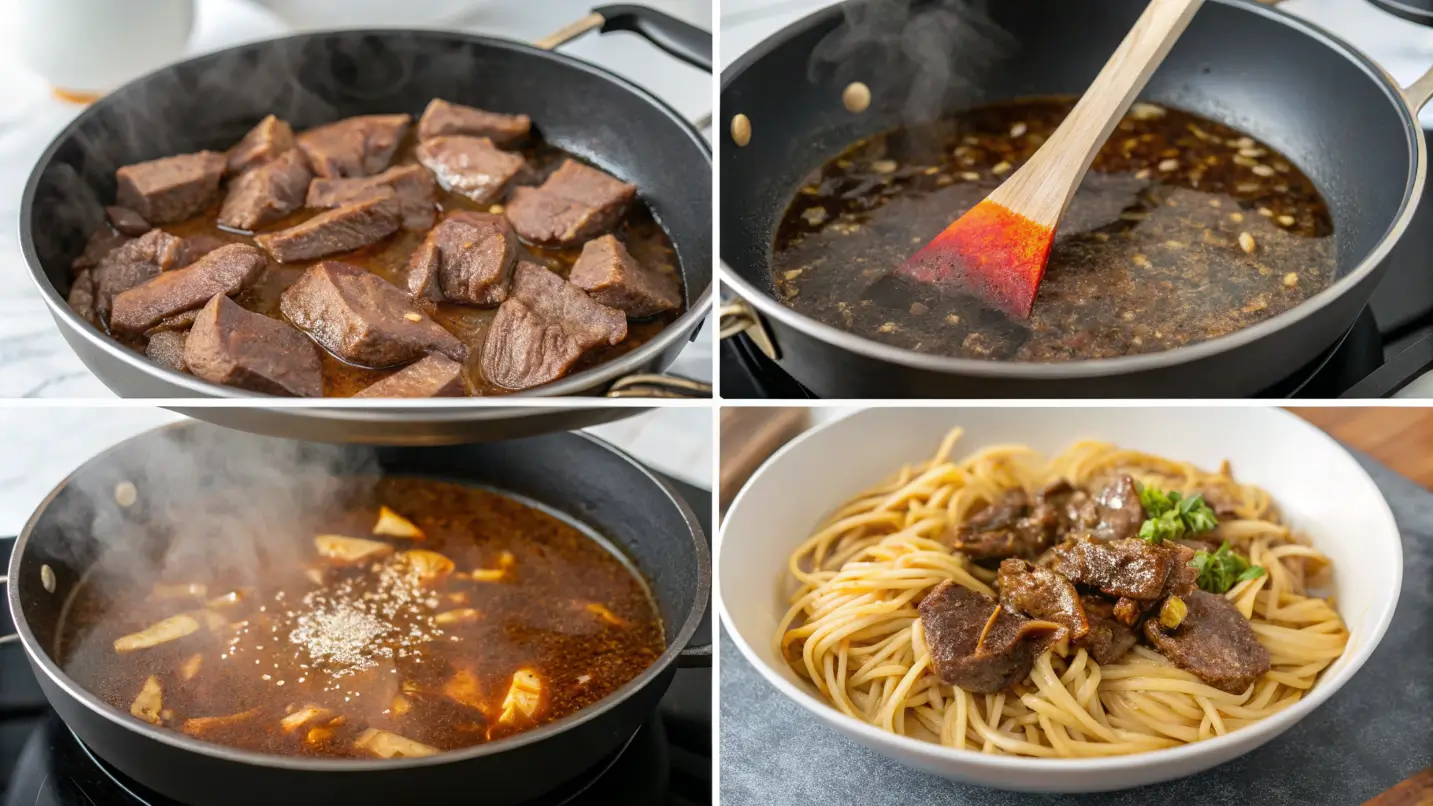
1. Build the Broth
Start with your base. For meat broths, roast the bones first to deepen flavor. Simmer with aromatics like onions, garlic, ginger, and leeks. Skim off impurities for a clearer broth. For a vegetarian version, add mushrooms, carrots, seaweed, and soy sauce for umami depth.
Let it simmer gently for 1–3 hours. The longer it goes, the better the flavor.
2. Cook the Noodles
Always cook noodles separately. This keeps the soup clear and prevents starch from clouding the broth. Boil according to package instructions, then rinse under cold water to stop cooking and keep the texture chewy.
3. Assemble the Soup
Pour hot broth into bowls. Add your noodles, then layer with toppings: sliced meats, tofu, greens, soft-boiled eggs, bean sprouts, or herbs. Drizzle with sesame oil or chili oil for extra flavor.
This step is your canvas—get creative with textures, colors, and garnishes!
4. Presentation Tips
Use deep bowls to hold broth well. Serve piping hot. Arrange ingredients neatly for that restaurant-worthy look. A sprinkle of sesame seeds or a lime wedge on the side adds a nice finishing touch.
And there you have it—a beautiful bowl of special noodle soup that’s made with heart and served with pride.
For more inspiration on making homemade broths and enhancing your noodle soups, check out this detailed guide on broths from Bon Appétit.
Regional Variations and Recipes
Vietnamese Pho
Pho (pronounced “fuh”) is arguably Vietnam’s most iconic dish—and for good reason. This fragrant noodle soup is built on layers of flavor, starting with a clear beef or chicken broth infused with spices like star anise, cinnamon, and cloves.
History & Regional Differences
Pho emerged in northern Vietnam in the early 20th century, influenced by Chinese and French culinary traditions. Over time, it spread throughout the country, taking on regional characteristics. Northern Pho (Pho Bac) is simpler, with a light, clean broth. Southern Pho (Pho Nam), on the other hand, is sweeter and more heavily garnished with bean sprouts, herbs, and hoisin sauce.
Authentic Preparation
A traditional Pho broth simmers for hours—sometimes overnight—to extract maximum flavor from beef bones and aromatic spices. It’s served with flat rice noodles, thinly sliced beef or chicken, and fresh herbs like Thai basil, cilantro, and green onion. A squeeze of lime and a few chili slices add that signature brightness and heat.
Japanese Ramen
Ramen is Japan’s soul food, with deep roots and endless variations. Unlike Pho, which emphasizes lightness, ramen is all about richness and bold flavor.
Types of Ramen
-
Shoyu: Soy sauce-based broth, often clear and savory.
-
Miso: Thick and hearty with fermented soybean paste.
-
Shio: Salt-based, light and delicate.
-
Tonkotsu: Creamy and rich, made by boiling pork bones for hours (can be adapted using chicken or vegetarian bases for pork-free versions).
Key Ingredients & Techniques
Ramen noodles are typically made with wheat and kansui (alkaline water), giving them their springy bite. The broth is simmered with garlic, ginger, onions, and seaweed, while toppings range from marinated eggs to mushrooms and seaweed. It’s a dish of infinite creativity—perfect for home chefs to experiment with.
Korean Janchi-guksu
Janchi-guksu literally translates to “banquet noodles” and is a festive dish in Korea, served at celebrations like weddings and birthdays.
Cultural Significance
These noodles symbolize longevity and happiness. Their simplicity and warmth represent comfort and care, making them a go-to for joyful occasions or cozy nights in.
Traditional Recipe
A light anchovy and kelp broth forms the base, while the thin wheat noodles are boiled separately. The soup is topped with sliced egg, julienned vegetables, and sometimes kimchi or zucchini. It’s often served with a side of soy-based dipping sauce for added depth.
Tibetan Thukpa
Thukpa is a traditional noodle soup of Tibetan origin, known for being hearty and spicy—perfect for cold, high-altitude climates.
Origins & Cultural Importance
With influences from neighboring Nepal, India, and China, Thukpa represents a blend of Himalayan flavors. It’s often served as a daily staple, bringing warmth and comfort to those living in mountainous regions.
Recipe Variations
While traditionally made with hand-pulled wheat noodles and meat, vegetarian versions are popular too. The broth is infused with garlic, ginger, chili, and local herbs. You might find additions like cabbage, carrots, tomatoes, and even yak meat in some areas. It’s the ultimate “everything-in-the-fridge” soup.
Taiwanese Beef Noodle Soup
Rich, bold, and deeply satisfying—Taiwanese Beef Noodle Soup is a national treasure that blends Chinese and local flavors.
Historical Background
This dish was developed by mainland Chinese immigrants in Taiwan after WWII. Over time, it evolved into its own identity—now celebrated in festivals and considered a comfort classic.
Key Ingredients & Cooking Methods
The broth is slow-cooked with soy sauce, ginger, garlic, and spices like star anise. It’s dark, savory, and slightly spicy. Thick wheat noodles hold up well to the strong flavors, and beef shank is commonly used for its tenderness. Often garnished with pickled greens and scallions, every spoonful is rich and layered.
Health Benefits and Nutritional Value
Nutritional Aspects of Noodle Soups
Noodle soups aren’t just tasty—they can be incredibly nourishing too. A well-balanced bowl combines proteins, carbohydrates, and a variety of vegetables, making it a complete meal in one.
Protein Sources
Chicken, beef, tofu, legumes, and seafood are common proteins found in noodle soups. They help with muscle repair and keep you feeling full longer.
Vegetables & Herbs
Vegetables like spinach, bok choy, carrots, and mushrooms contribute essential nutrients such as fiber, antioxidants, and a wide range of vitamins. Meanwhile, herbs like basil and cilantro not only boost the taste but also support overall wellness with their natural health properties.
Broth Benefits
A clear, homemade broth—especially bone or vegetable-based—is packed with minerals, collagen, and amino acids. It also aids digestion and keeps you hydrated.
Carbohydrates
Noodles provide the energy kick. Opt for whole grain, buckwheat, or rice noodles to increase fiber intake and stabilize blood sugar.
So when built right, a noodle soup is more than comfort—it’s functional food.
Customizing for Dietary Needs
With just a few tweaks, noodle soup can be made to suit nearly any dietary requirement.
Vegetarian & Vegan Options
Swap meat broths for a rich mushroom or seaweed stock. Use tofu, tempeh, or legumes as protein, and load up on seasonal veggies. Umami-packed ingredients like miso, soy sauce, and fermented chili paste add depth without animal products.
Low-Sodium Adjustments
Use low-sodium soy sauce or tamari. Add natural flavors with herbs, spices, garlic, ginger, and a splash of lemon or vinegar for brightness. Avoid store-bought seasoning packets, which are often high in salt.
Gluten-Free Variations
Choose rice noodles, glass noodles, or certified gluten-free soba. Double-check sauces and condiments, and consider tamari instead of soy sauce.
Boosting with Superfoods
Add spinach, kale, or moringa for iron and antioxidants. Sprinkle hemp seeds or chia for omega-3s. A touch of turmeric or ginger can offer anti-inflammatory benefits.
When customized thoughtfully, special noodle soup can fit any lifestyle—and still taste amazing.
Frequently Asked Questions (FAQ)
What is the best type of noodle for soup?
That depends on the style of soup you’re making. For example:
-
Rice noodles work beautifully in Pho.
-
Wheat noodles are perfect for ramen or Janchi-guksu.
-
Soba (buckwheat) noodles add a nutty depth to lighter broths. The key is to match the noodle’s texture and flavor to your broth. Firm, chewy noodles hold up better in hearty broths, while delicate noodles shine in light, clear soups.
How do I make a vegetarian noodle soup broth?
Start with aromatics like onion, garlic, and ginger. Add mushrooms (shiitake or cremini work great), carrots, celery, and a piece of dried seaweed (like kombu) for umami. Simmer for at least an hour, then strain. Add a splash of soy sauce or miso for depth. You’ll be amazed at how rich a meat-free broth can be!
Can I use instant noodles in homemade soups?
Absolutely—but with a twist. Ditch the seasoning packet (usually high in sodium and additives) and cook the noodles in your own broth. Instant noodles can be a convenient shortcut, but the flavor should come from your carefully crafted soup base and toppings.
How long should I simmer the broth for maximum flavor?
The magic number is at least one hour. But for deeper flavor—especially with bone-based broths—aim for 3 to 4 hours. Slow simmering allows all the herbs, spices, and bones to release their full essence. Don’t forget to skim off impurities for a clean, clear broth.
What are some common mistakes to avoid when making noodle soup?
-
Overcooking the noodles: They should be cooked separately to avoid mushiness.
-
Not seasoning the broth enough: Always taste and adjust as you go.
-
Adding all ingredients at once: Layer your flavors by adding delicate items last.
-
Cloudy broth: Boil gently and skim to keep it clear.
-
Neglecting garnish: Fresh herbs and citrus can totally elevate your final bowl.
Embracing the Diversity of Noodle Soups
From the bustling streets of Hanoi to the snowy slopes of the Himalayas, special noodle soup has found its way into every corner of the culinary world. It’s a dish that wears many hats—comfort food, celebration meal, remedy for rainy days, and even a symbol of long life and happiness.
What makes noodle soup so special isn’t just the broth or the noodles—it’s the story in every bowl. Each variation tells us something about a culture, a people, or a tradition. Whether it’s Pho’s fragrant complexity or Thukpa’s warming spice, these soups connect us through shared flavors and human experiences.
And the best part? You don’t need to be a chef or live near a specialty market to enjoy them. With a few key ingredients, a bit of patience, and a lot of love, you can craft your own version right at home.
So, go ahead—experiment. Mix and match noodles, create your own broths, or swap in vegetables you love. Cooking isn’t just about following rules—it’s about finding joy and making something yours.
Because at the end of the day, special noodle soup isn’t just a recipe. It’s a journey. And every bowl is worth savoring.
Print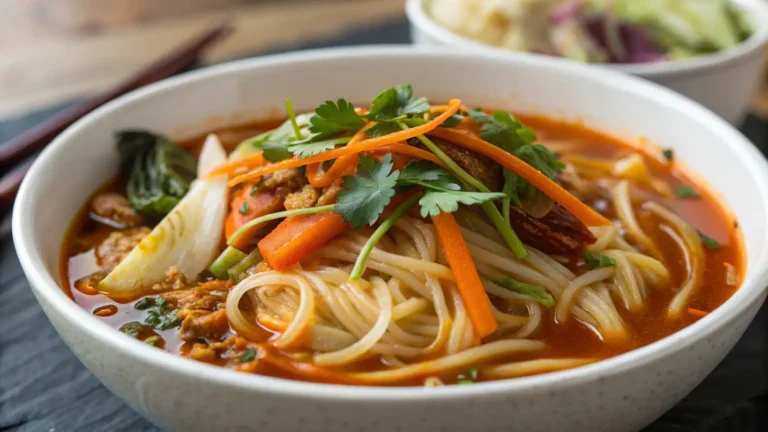
Special Noodle Soup
A heartwarming bowl of Special Noodle Soup that combines flavorful broth, tender noodles, and a variety of fresh vegetables. This dish is an aromatic mix of herbs, spices, and savory goodness that will leave you feeling satisfied. Ideal for all seasons, it’s customizable with different protein choices like beef, chicken, or tofu.
- Total Time: 45 minutes
- Yield: 4 servings 1x
Ingredients
For the Broth:
- 6 cups of chicken broth (or vegetable broth for vegetarian option)
- 1 onion, quartered
- 4 cloves garlic, smashed
- 1-inch piece of ginger, sliced
- 2 star anise
- 1 cinnamon stick
- 2 tbsp soy sauce
- 1 tbsp fish sauce
- 1 tsp sugar (optional)
- Salt to taste
For the Noodles:
- 200g wheat noodles (or rice noodles for gluten-free option)
Vegetables:
- 1 cup bok choy, chopped
- 1/2 cup mushrooms, sliced
- 1/2 cup carrots, julienned
- 1/2 cup spinach
For Toppings:
- Fresh cilantro, chopped
- Lime wedges
- Sliced chili peppers (optional)
- Sesame oil (for drizzling)
Optional Protein (Choose one):
- 1/2 lb chicken breast, thinly sliced
- 1/2 lb beef sirloin, thinly sliced
- 1/2 block tofu, cubed (for vegetarian option)
Instructions
- Prepare the Broth:
In a large pot, add the chicken broth, onion, garlic, ginger, star anise, cinnamon stick, soy sauce, fish sauce, and sugar. Bring to a boil, then reduce to a simmer. Let it cook for 25-30 minutes to allow the flavors to infuse. Taste and adjust seasoning with salt as needed. - Cook the Noodles:
While the broth simmers, cook the noodles according to the package instructions. Drain and set aside. - Prepare the Vegetables:
In a separate pan, sauté the mushrooms, carrots, and bok choy for 3-4 minutes until they soften. Add the spinach at the end and sauté for an additional minute, just to wilt the spinach. - Assemble the Soup:
In serving bowls, place a portion of cooked noodles. Pour the hot broth over the noodles and add the sautéed vegetables. - Add Protein:
If using meat or tofu, add it to the hot broth to cook briefly, or place it directly on top of the soup. - Garnish and Serve:
Top each bowl with fresh cilantro, lime wedges, chili peppers, and a drizzle of sesame oil. Serve hot and enjoy!
Notes
- For a deeper flavor, let the broth simmer longer, or even overnight.
- You can substitute the soy sauce with tamari for a gluten-free option.
- If you prefer a spicier broth, add extra chili peppers or a dash of chili oil.
- For a lighter broth, you can skip the fish sauce.
- Prep Time: 15 minutes
- Cook Time: 30 minutes
- Category: Main Course
- Method: Simmering
- Cuisine: Asian Fusion
- Diet: Gluten Free
Nutrition
- Serving Size: 1 bowl
- Calories: 350
- Sugar: 4g
- Sodium: 1,200mg
- Fat: 12g
- Saturated Fat: 1.5g
- Unsaturated Fat: 9g
- Trans Fat: 0g
- Carbohydrates: 45g
- Fiber: 5g
- Protein: 20g
- Cholesterol: 45mg
Keywords: Special noodle soup, homemade broth, Asian noodle soup, healthy noodle soup, customizable noodle soup
